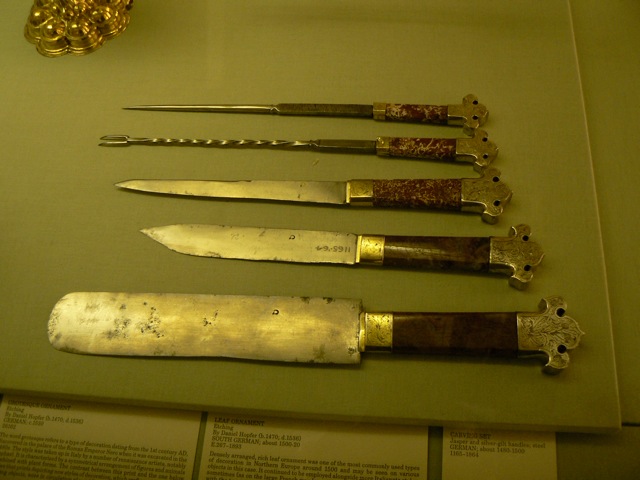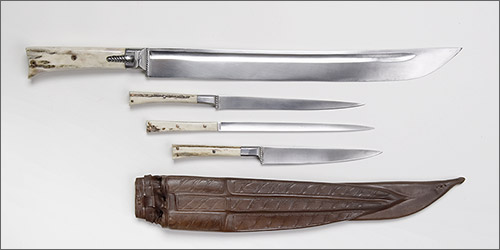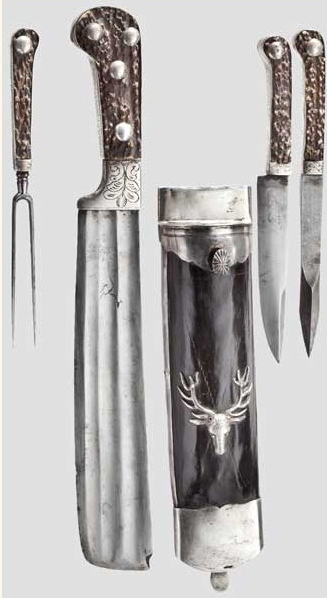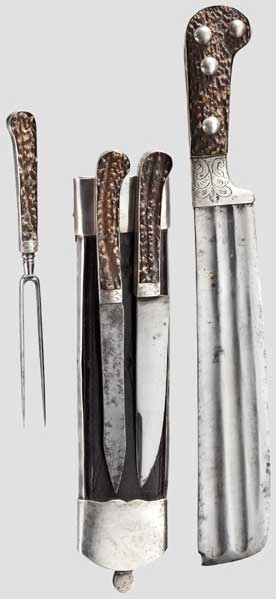| Author |
Message |
|
Peter Johnsson
Industry Professional
|
 Posted: Mon 31 Aug, 2009 2:44 am Post subject: The mysterious (?) pricker Posted: Mon 31 Aug, 2009 2:44 am Post subject: The mysterious (?) pricker |
 |
|
All this talk about sharpness lately reminded me to post a image from V&A of a set of carving/serving knives.
Interestingly the set includes both a fork *and* a pricker.
In the scabbard of many knives and some swords from the 14th - 16th C you can see a set of by-knife and/or a steel awl, or pricker. Or at least that is how it is often interpreted.
Of course this tool would work well as an awl for various purposes, and possible also double as a fork at the table.
But I have wondered if the pricker/awl primarily is intended as a sharpening steel: something that makes much more sense to have close at hand for touching up an edge whenever it has lost some of its bite.
Seeing the table knives at the V&A was exiting: here we see a dedicated fork as well as a pricker is included in the set. The file can help establish a new raw edge, and the steel needle is used to polish the edge into a fne cutting sharpness.
 Attachment: 74.69 KB Attachment: 74.69 KB

The complete set...
 Attachment: 27.32 KB Attachment: 27.32 KB

And a close up of the fork and steel.
|
|
   |
 |
|
Al Muckart
|
 Posted: Mon 31 Aug, 2009 3:56 am Post subject: Posted: Mon 31 Aug, 2009 3:56 am Post subject: |
 |
|
It's an interesting idea. I recently had a pair of prickers made to match some 15thC knives and had the smith leave them quite hard so I could try using them as steels.
That said, I'm not that convinced the fork is a pricker-substitute. Prickers predate table forks by quite a long time, and the dimensions of that fork, for example, are all wrong for a carving tool. It's a pretty good size for a serving tool though.
Meat in medieval times wasn't sliced the way we do today, it was carved into chunks suitable to be eaten with the fingers, and that fork strikes me as a pretty good tool for transporting bite-size bits of meat from board to bowl.
--
Al.
http://wherearetheelves.net
|
|
   |
 |
|
Adam S.
|
 Posted: Mon 31 Aug, 2009 11:04 am Post subject: Posted: Mon 31 Aug, 2009 11:04 am Post subject: |
 |
|
Thomas a Becket: Tonight you can do me the honor of christening my forks.
King Henry II: Forks?
Thomas a Becket: Yes, from Florence. New little invention. It's for pronging meat and carrying it to the mouth. It saves you dirtying your fingers.
King Henry II: But then you dirty the fork.
Thomas a Becket: Yes, but it's washable.
King Henry II: So are your fingers. I don't see the point.
Sorry, I couldn't resist.
I've been wondering the same thing for a while now. Is it possible that the "pricker" was all of these things? Meat skewer, sharpening steel, and awl? The idea of a multipurpose tool can't be THAT modern.
|
|
  |
 |
Eric Hejdström

Location: Visby, Sweden Joined: 13 Mar 2007
Posts: 184
|
 Posted: Mon 31 Aug, 2009 4:31 pm Post subject: Posted: Mon 31 Aug, 2009 4:31 pm Post subject: |
 |
|
I read somwhere that it's supposed to be a sharpening steel but I can't remember where. Christopher Gravett writes in his book "Knight" that is't called a bodkin (and not the arrowhead here) and was commonly worn with different knives and/or swords. He also mentions that it might have been used to make holes for points, for wich it would be fairly suitable.
I discussed this with an aquaintance of mine and he didn't belive it since they seldom (never before the 1600's as far as I know) have the small ridges as modern sharpening sttels have. However, I made one and left two edges of the square section of the pricker/bodkin quite sharp. The 90 degree angle works very well for removing small nicks and similar on the knife. Further sharpening can easily be achived with a small whetstone but if you need to get rid of slightly larger grades on teh edge this little implement will do the trick. So far I haven't gotten any proff to back me up on this but empirical tests on my own equipment have so far proven useful.
Would like to see more pictures of prickers/bodkins in the future!
/Eric
|
|
  |
 |
|
Peter Johnsson
Industry Professional
|
 Posted: Mon 31 Aug, 2009 11:26 pm Post subject: Posted: Mon 31 Aug, 2009 11:26 pm Post subject: |
 |
|
| Eric Hejdström wrote: | I read somwhere that it's supposed to be a sharpening steel but I can't remember where. Christopher Gravett writes in his book "Knight" that is't called a bodkin (and not the arrowhead here) and was commonly worn with different knives and/or swords. He also mentions that it might have been used to make holes for points, for wich it would be fairly suitable.
I discussed this with an aquaintance of mine and he didn't belive it since they seldom (never before the 1600's as far as I know) have the small ridges as modern sharpening sttels have. However, I made one and left two edges of the square section of the pricker/bodkin quite sharp. The 90 degree angle works very well for removing small nicks and similar on the knife. Further sharpening can easily be achived with a small whetstone but if you need to get rid of slightly larger grades on teh edge this little implement will do the trick. So far I haven't gotten any proff to back me up on this but empirical tests on my own equipment have so far proven useful.
Would like to see more pictures of prickers/bodkins in the future!
/Eric |
Bodkin would imply the point is an essential part of the design: possibly an argument against it being a steel.
I would like to know for certain if this name is known from period texts with this meaning.
A steel does not have to have ridges/serrations to function as a sharpening tool, however. Some steels are smooth polished rods. This works pretty well if the steel in the edge is a bit on the soft side, as you would expect sword blades and many knives were back in the days.
I shall keep an eye open for bodkins with square corners. Never seen one as of yet.
|
|
   |
 |
Eric Hejdström

Location: Visby, Sweden Joined: 13 Mar 2007
Posts: 184
|
 Posted: Wed 02 Sep, 2009 2:35 pm Post subject: Posted: Wed 02 Sep, 2009 2:35 pm Post subject: |
 |
|
I've been trying to find out more about the name bodkin for the pricker tool but so far I haven't found any good sources at all. Almost everywhere else in literature a bodkin is an arrowhead. Gravett mentions bodkins on several places in the book and it's only the subject of the text that implies whetter or not it's the arrowhead or the pricker that's discussed.
And offcourse I have misplaced the picture I had of a bodkin/pricker which was partially square... I'll promise to post the picture as soon as I find it again!
|
|
  |
 |
|
Eric W. Norenberg
|
 Posted: Wed 02 Sep, 2009 9:43 pm Post subject: Posted: Wed 02 Sep, 2009 9:43 pm Post subject: |
 |
|
| Eric Hejdström wrote: | | I've been trying to find out more about the name bodkin for the pricker tool but so far I haven't found any good sources... |
I've seen the term bodkin used either in place of the term kogai, or in description of the same thing. Quick google search will find you a few examples of this usage. It isn't too far of a stretch to guess that a few authors have conflated the wakizashi-scabbard-mounted pointy grooming thingy with the european-scabbard-mounted pricker thingy, and carried the word bodkin over from there.
Man, I love the V&A - anyone within a day's travel has my sincere envy. That particular pricker that Peter has in question is very cool, I've never seen one as part of a table set before. Peter, did you make note of the set's age? I might be off in this conjecture, but I do know that there were some fairly elaborate customs/table manners regarding the carving of any "roast beast" at hand, and I can certainly imagine the pricker being the left hand to the carving knife in the right. Then the long, fondue-like fork pictured with would be used for transferring from platter to plate (or trencher) as Mr. Muckart noted. That arrangement would make the pricker's use as a steel as well make perfect sense.
Does anybody out there have any good, close photos of surviving scabbard-mounted prickers? Maybe there are a few out there with some kind of tell-tale wear marks that would suggest a sharpening function?
-Eric
|
|
  |
 |
M. Eversberg II

|
 Posted: Thu 03 Sep, 2009 5:01 am Post subject: Posted: Thu 03 Sep, 2009 5:01 am Post subject: |
 |
|
Is the one on the bottom some kind of edgeless serving spatula, or a kind of knife? It's hard to see the edges.
M.
This space for rent or lease.
|
|
      |
 |
|
Mick Czerep
Location: Poland Joined: 30 May 2007
Posts: 59
|
 Posted: Thu 03 Sep, 2009 5:49 am Post subject: Posted: Thu 03 Sep, 2009 5:49 am Post subject: |
 |
|
It's a serving knife. Indeed, a kind of a blunt spatula, rather like a cake-serving thingy in use. In Medieval courtly sets these were quite common.
Sordes ocurrit
|
|
   |
 |
|
Martin Fischer
Location: Cologne, Germany Joined: 21 Jul 2007
Posts: 45
|
 Posted: Thu 03 Sep, 2009 12:01 pm Post subject: Posted: Thu 03 Sep, 2009 12:01 pm Post subject: |
 |
|
| Peter Johnsson wrote: |
I shall keep an eye open for bodkins with square corners. Never seen one as of yet. |
Hello,
try to contact Manfred Pany:
http://www.manfred-pany.de/index.php?title=kontakt
He made some replicas with square corners and should know about some originals.
Regards
Martin
|
|
  |
 |
Mark T

|
 Posted: Tue 11 Jan, 2011 10:10 pm Post subject: Posted: Tue 11 Jan, 2011 10:10 pm Post subject: |
 |
|
Sorry for the threadromancy, but does anyone have any other examples of prickers that included a 'file' section - or any other source documentation to suggest they could have been used as sharpening steels?
Chief Librarian/Curator, Isaac Leibowitz Librarmoury
Schallern sind sehr sexy!
|
|
  |
 |
Nathan Robinson
myArmoury Admin


|
 Posted: Tue 11 Jan, 2011 10:48 pm Post subject: Posted: Tue 11 Jan, 2011 10:48 pm Post subject: |
 |
|
When Tod made a stag bauernwehr and by-knives set that I now own, he left the pricker fully hard so that it can be used as a sharpener. It doesn't have a "file-edge" on it, but is more of a four-sided hollow-ground shape that has four "edges" that can be used against a sharp blade's edge. It works well. I've used it to sharpen the by-knives to be very, very sharp. I used it to hone the large piece after I did some cutting of thick-walled cardboard tubes with it (it's a surprisingly good cutter) and it returned the edge to as good as new.

The main piece is very large! It's really a medium-sized grosse-messer. (Would that be a mittelstand-messer?)
Overall length: 18.375"
Weight: 1.1 pounds
Blade: 13.25" long; 1.25" wide at the base
I will be publishing a collection gallery page with this item soon. It's completed already and just waiting to go live.
.:. Visit my Collection Gallery :: View my Reading List :: View my Wish List :: See Pages I Like :: Find me on Facebook .:.
|
|
    |
 |
Mark T

|
 Posted: Wed 12 Jan, 2011 3:05 am Post subject: Posted: Wed 12 Jan, 2011 3:05 am Post subject: |
 |
|
Hi Nathan, Thanks for reminding us all of that fantastic set! (Something about that Bauernwehr makes me also think 'Jagdmesser' ...)
Anyway, some searcing on Hermann Historica found two knife sets where what looks like it would have been called a pricker in an earlier timeframe is here referred to as a 'bodkin' or 'sharpening steel' ...
Set 1 (pics below) is here: http://www.hermann-historica.de/auktion/hhm60...at60_m.txt
So: does this support Peter's proposal that prickers could also have been used as sharpening steels? I guess the other interpretations are that a similar form of tool persisted, but with a different construction and use ... or that HH are incorrect ... I'm voting for the pricker also being used a sharpening steel! 
 Attachment: 121.5 KB Attachment: 121.5 KB

 Attachment: 116.9 KB Attachment: 116.9 KB

 Attachment: 85.55 KB Attachment: 85.55 KB

 Attachment: 79.76 KB Attachment: 79.76 KB

Chief Librarian/Curator, Isaac Leibowitz Librarmoury
Schallern sind sehr sexy!
Last edited by Mark T on Wed 12 Jan, 2011 4:30 am; edited 1 time in total
|
|
  |
 |
Mark T

|
|
  |
 |
Jean Thibodeau

|
 Posted: Wed 12 Jan, 2011 4:27 am Post subject: Posted: Wed 12 Jan, 2011 4:27 am Post subject: |
 |
|
| Nathan Robinson wrote: | When Tod made a stag bauernwehr and by-knives set that I now own, he left the pricker fully hard so that it can be used as a sharpener. It doesn't have a "file-edge" on it, but is more of a four-sided hollow-ground shape that has four "edges" that can be used against a sharp blade's edge. It works well. I've used it to sharpen the by-knives to be very, very sharp. I used it to hone the large piece after I did some cutting of thick-walled cardboard tubes with it (it's a surprisingly good cutter) and it returned the edge to as good as new.
|
Yes I use a hardened steel spike I had custom made decades ago for the same thing and it also works well to maintain an edge but would take forever to sharpen anything even a bit dull.
Mostly it realigns a microscopically bent over edge or can refine an edge just sharpened by removing the wire edge.
It certainly does a good job of burnishing the edge to an almost mirror polish if the main abrasive used to sharpen was a fine grit one.
I use it on my Albions and other swords just to refresh an edge that may have lots a little " freshness " just by rubbing in and out of a scabbard.
Oh, very nice nice set of knives and, as you probably remember, I have an Eared Dagger on order from Tod and every time I see some more of Tod's work I very much look forward to see what he is going to do.   By the way I took your advice and I'm mostly letting Tod deal with all the design and aesthetic details rather than micromanaging the project. I want to be surprised and I'm confident that it will be a very nice piece worth bragging about like your bauernwehr and by-knives. By the way I took your advice and I'm mostly letting Tod deal with all the design and aesthetic details rather than micromanaging the project. I want to be surprised and I'm confident that it will be a very nice piece worth bragging about like your bauernwehr and by-knives.
Like the tooling on the scabbard also.
You can easily give up your freedom. You have to fight hard to get it back!
|
|
  |
 |
|
Matthew Stagmer
Industry Professional
Location: Maryland, USA Joined: 23 Jan 2008
Posts: 493
|
 Posted: Wed 12 Jan, 2011 5:47 am Post subject: Posted: Wed 12 Jan, 2011 5:47 am Post subject: |
 |
|
Sure. I dont think it would be a stretch at all to say that it could have been more often used as a sharpening device. All you are trying to do there is remove or straighten out a slight bur and it would work fine. I had heard once that if you look at the spine of most early eating knives that they will almost always have scratches from de-buring another knife on it. They had to do it often. Much more often then modern kitchen knives.
Matthew Stagmer
Maker of custom and production weaponry
Youtube.com/ThatWorks
|
|
   |
 |
Christian G. Cameron

|
 Posted: Wed 12 Jan, 2011 6:53 pm Post subject: Posted: Wed 12 Jan, 2011 6:53 pm Post subject: |
 |
|
If that's a hunting garniture--and it may well not be--then the fork and the pricker have different uses in the formal breaking up of the deer carcass in formal Par Force Stag/Hind hunting. At the Curee. If you think this is applicable, someone tell me and I'll look up what they're all for... my memory is hazy. I THINK the fork was for displaying the heart, and the pricker if for... displaying something else. Been a while.
Christian G. Cameron
Qui plus fait, miex vault
www.hippeis.com
|
|
   |
 |
|
|

